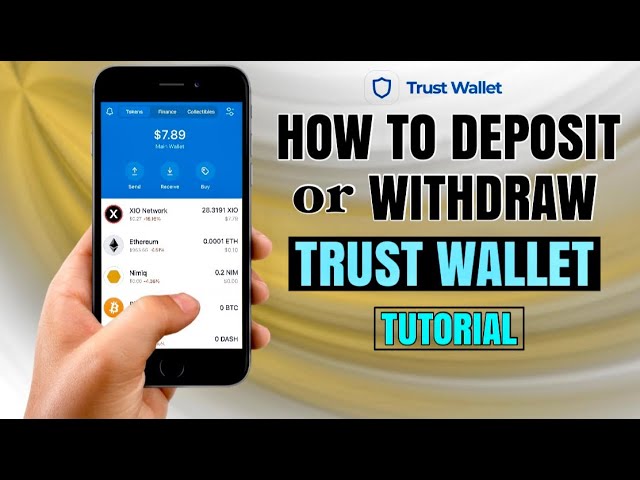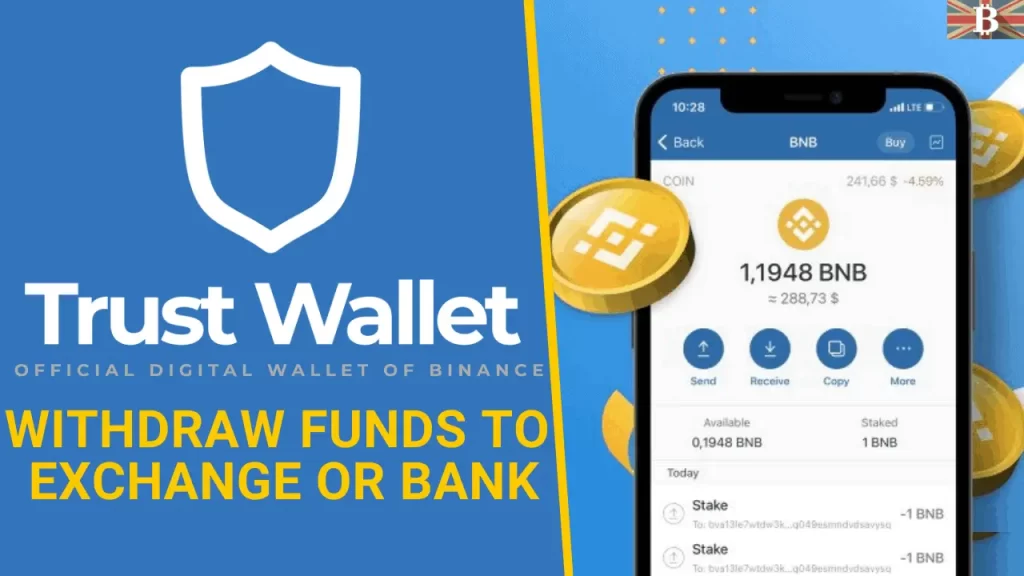Yes, you can use Trust Wallet to transfer money, but only in the form of cryptocurrencies. Trust Wallet allows you to send and receive various cryptocurrencies to and from other digital wallets, enabling you to manage and transfer your digital assets securely.

Security Measures for Safe Depositing
- Use a Secure Internet Connection: Always ensure your internet connection is secure when accessing your Trust Wallet. Avoid public Wi-Fi networks, as they are more susceptible to interceptions and attacks. Consider using a VPN for an added layer of security.
- Enable Security Features: Trust Wallet offers several security features, such as biometric access (fingerprint or facial recognition) and a passcode. Ensure these features are enabled to prevent unauthorized access.
- Regularly Update Your Wallet: Keep your Trust Wallet app updated to the latest version. Updates often include security patches that protect against new vulnerabilities.
- Verify Transaction Details: Before confirming any deposit, double-check the recipient’s address. A single mistake can result in irreversible loss.
- Backup Your Wallet: Securely back up your wallet recovery phrase. This phrase is crucial for accessing your funds if your device is lost, stolen, or if you need to reinstall Trust Wallet.
Tips to Secure Your Wallet Before Depositing
- Educate Yourself: Understand the basics of cryptocurrency and the security risks involved. Knowledge is your first line of defense against scams and phishing attempts.
- Use a Dedicated Device: If possible, use a dedicated device for your cryptocurrency transactions. This device should have minimal apps and be free from malware.
- Secure Your Recovery Phrase: Write down your recovery phrase and store it in a secure location. Never share it with anyone or store it online.
- Monitor Your Wallet: Regularly check your wallet’s transaction history for any unauthorized activity. Set up notifications if Trust Wallet supports them.
How to Recover Your Account in Case of Security Breaches
- Using Your Recovery Phrase: If you suspect a security breach, immediately use your recovery phrase to restore your wallet on a secure device. This can help regain control before any unauthorized transactions are processed.
- Contact Support: If you’re unable to recover your wallet using your recovery phrase, contact Trust Wallet’s support team. Provide them with any relevant information to prove ownership of the wallet.
- Secure Your Device: Ensure your device is free from malware or viruses. Use reputable antivirus software to scan and remove any threats.

The Role of Two-Factor Authentication (2FA)
- Enhanced Security: Two-factor authentication adds an extra layer of security by requiring two forms of verification before accessing your wallet. This could be something you know (a password), something you have (a mobile device), or something you are (biometric verification).
- Implementation: While Trust Wallet primarily relies on secure access methods like biometrics and recovery phrases, for platforms that support it, enabling 2FA through an authenticator app or SMS verification can significantly reduce the risk of unauthorized access.
- Recovery Options: Ensure you have backup access methods in case you lose your primary 2FA device. This often involves backup codes or the ability to disable 2FA temporarily with the support of the platform’s customer service.
In conclusion, securing your Trust Wallet involves a combination of using built-in security features, practicing safe depositing habits, being prepared for recovery in case of breaches, and understanding the role of 2FA. Always stay informed about the latest security practices and updates from Trust Wallet to protect your cryptocurrency assets effectively.
The Importance of Account Verification
Account verification is a crucial security measure that helps protect your digital assets from unauthorized access and fraudulent activities. It ensures that you are the legitimate owner of the account and enhances the trustworthiness of transactions made from your wallet. Verification processes can also be essential for recovering your account in case you lose access, as they provide an additional layer of information that confirms your identity.
How to Verify Your Account
Trust Wallet is designed with a strong focus on user privacy and security, operating primarily as a non-custodial wallet. This means that Trust Wallet doesn’t hold your cryptocurrencies directly nor does it store your personal information on its servers. As such, the traditional account verification process, as seen on centralized exchanges, doesn’t apply in the same way. Instead, ensuring your wallet’s security and proving ownership revolves around the safeguarding and correct usage of your recovery phrase.
- Backup Your Recovery Phrase: When you create a new wallet, Trust Wallet generates a 12-word recovery phrase. This phrase is the key to your wallet and its assets. Make sure to write it down and store it securely in multiple locations. Never share this phrase with anyone.
- Secure Your Device: Use device-level security features such as biometric locks or secure PINs to add an additional layer of security.
- Verify Wallet Integrity: Regularly ensure that you’re using the official Trust Wallet app from a reputable source, such as the iOS App Store or Google Play Store, to prevent phishing or counterfeit applications.
Troubleshooting Verification Issues
Since Trust Wallet doesn’t use traditional account verification methods, troubleshooting “verification” issues mainly involves ensuring you have secure and uninterrupted access to your wallet. Here are some common issues and their solutions:
- Lost Recovery Phrase: If you’ve lost your recovery phrase, there’s unfortunately no way to directly recover your wallet through Trust Wallet or any third party. This underscores the importance of securely storing your recovery phrase. Prevention is crucial.
- Suspicious Activity or Unauthorized Access: If you suspect your wallet has been compromised, the first step is to transfer your assets to a new wallet for which only you have the recovery phrase. Then, investigate the security of your devices and consider changing related passwords and security settings.
- Issues with Transactions or Access: Ensure your Trust Wallet app is up to date. Older versions may have compatibility issues. Also, verify your internet connection and, if necessary, restart your device to solve any device-specific problems.
Remember, the security of your Trust Wallet and its contents depends heavily on keeping your recovery phrase safe and practicing good digital security hygiene. Unlike accounts on centralized platforms, the decentralized nature of wallets like Trust Wallet places much of the responsibility for security in the user’s hands.
Enabling Two-Factor Authentication
While Trust Wallet itself does not use 2FA because it grants users full control over their keys and does not require user accounts, you can still apply the principle of two-factor authentication in a broader security context. For any service linked to your cryptocurrency dealings, such as exchanges or platforms used to purchase cryptocurrencies before transferring them to your Trust Wallet, ensure 2FA is enabled. This can include:
- Email Accounts: Your email might be used for recovery options or notifications. Enable 2FA to add an extra layer of security.
- Cryptocurrency Exchanges: Before transferring crypto to your Trust Wallet, secure your exchange accounts with 2FA.
- Backup Solutions: If you use cloud storage to keep encrypted backups of your recovery phrase or other sensitive information, make sure 2FA is enabled on these services as well.
Using a Secure and Private Internet Connection
The security of your internet connection is paramount when managing digital assets. Public Wi-Fi networks are notoriously insecure, making them ripe for intercepting data, including potentially sensitive information related to your cryptocurrency transactions. To protect your assets:
- Avoid Public Wi-Fi: Refrain from accessing your Trust Wallet or performing transactions over public Wi-Fi networks.
- Use a VPN: A Virtual Private Network (VPN) encrypts your internet connection, making it more difficult for attackers to intercept or spy on your activities. Use a reputable VPN service whenever you access your wallet or conduct transactions.
- Secure Home Network: Ensure your home Wi-Fi is protected with a strong password and WPA2 or WPA3 encryption. Regularly update your router’s firmware to protect against vulnerabilities.

Regularly Updating Your Trust Wallet App
Keeping your Trust Wallet app updated is crucial for security. Developers regularly release updates that not only introduce new features but also patch known vulnerabilities that could be exploited by attackers. To maintain the highest level of security:
- Enable Automatic Updates: On your device, enable automatic updates for apps to ensure you’re always running the latest version of Trust Wallet.
- Monitor Official Channels: Follow Trust Wallet’s official channels, such as their blog or social media, for announcements regarding updates or important security advisories.
- Beware of Phishing: Always download updates directly from the Google Play Store, Apple App Store, or the official Trust Wallet website. Be cautious of emails or messages directing you to download updates from other sources, as these could be phishing attempts.
Implementing these security measures effectively minimizes the risk associated with managing digital assets and ensures that your deposits in Trust Wallet are protected against the evolving landscape of online threats.
